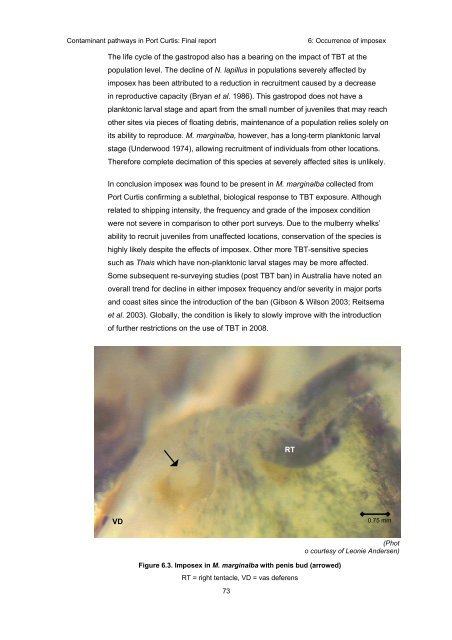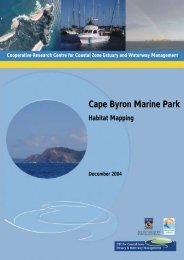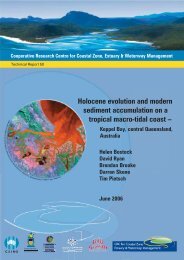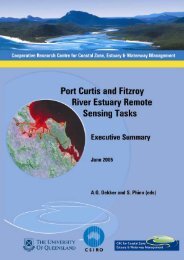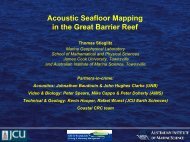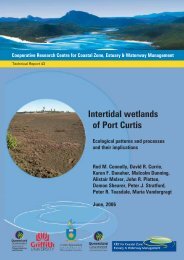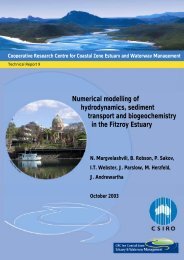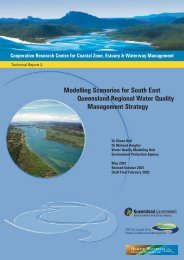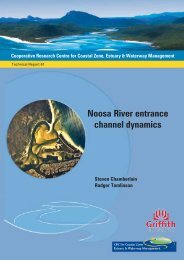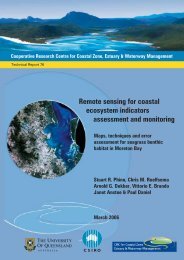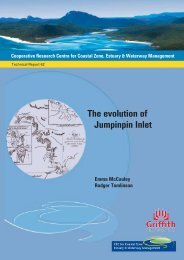Contaminant pathways in Port Curtis: Final report - OzCoasts
Contaminant pathways in Port Curtis: Final report - OzCoasts
Contaminant pathways in Port Curtis: Final report - OzCoasts
You also want an ePaper? Increase the reach of your titles
YUMPU automatically turns print PDFs into web optimized ePapers that Google loves.
<strong>Contam<strong>in</strong>ant</strong> <strong>pathways</strong> <strong>in</strong> <strong>Port</strong> <strong>Curtis</strong>: F<strong>in</strong>al <strong>report</strong>6: Occurrence of imposexThe life cycle of the gastropod also has a bear<strong>in</strong>g on the impact of TBT at thepopulation level. The decl<strong>in</strong>e of N. lapillus <strong>in</strong> populations severely affected byimposex has been attributed to a reduction <strong>in</strong> recruitment caused by a decrease<strong>in</strong> reproductive capacity (Bryan et al. 1986). This gastropod does not have aplanktonic larval stage and apart from the small number of juveniles that may reachother sites via pieces of float<strong>in</strong>g debris, ma<strong>in</strong>tenance of a population relies solely onits ability to reproduce. M. marg<strong>in</strong>alba, however, has a long-term planktonic larvalstage (Underwood 1974), allow<strong>in</strong>g recruitment of <strong>in</strong>dividuals from other locations.Therefore complete decimation of this species at severely affected sites is unlikely.In conclusion imposex was found to be present <strong>in</strong> M. marg<strong>in</strong>alba collected from<strong>Port</strong> <strong>Curtis</strong> confirm<strong>in</strong>g a sublethal, biological response to TBT exposure. Althoughrelated to shipp<strong>in</strong>g <strong>in</strong>tensity, the frequency and grade of the imposex conditionwere not severe <strong>in</strong> comparison to other port surveys. Due to the mulberry whelks’ability to recruit juveniles from unaffected locations, conservation of the species ishighly likely despite the effects of imposex. Other more TBT-sensitive speciessuch as Thais which have non-planktonic larval stages may be more affected.Some subsequent re-survey<strong>in</strong>g studies (post TBT ban) <strong>in</strong> Australia have noted anoverall trend for decl<strong>in</strong>e <strong>in</strong> either imposex frequency and/or severity <strong>in</strong> major portsand coast sites s<strong>in</strong>ce the <strong>in</strong>troduction of the ban (Gibson & Wilson 2003; Reitsemaet al. 2003). Globally, the condition is likely to slowly improve with the <strong>in</strong>troductionof further restrictions on the use of TBT <strong>in</strong> 2008.RTVD0.75 mmFigure 6.3. Imposex <strong>in</strong> M. marg<strong>in</strong>alba with penis bud (arrowed)RT = right tentacle, VD = vas deferens73(Photo courtesy of Leonie Andersen)


